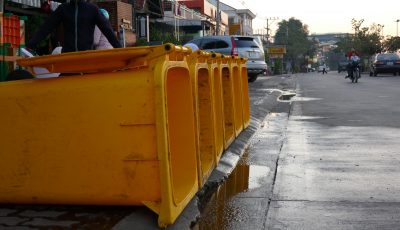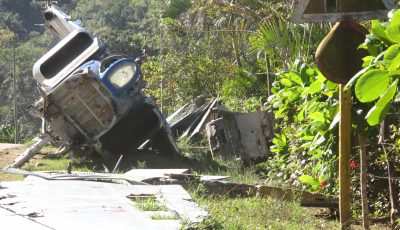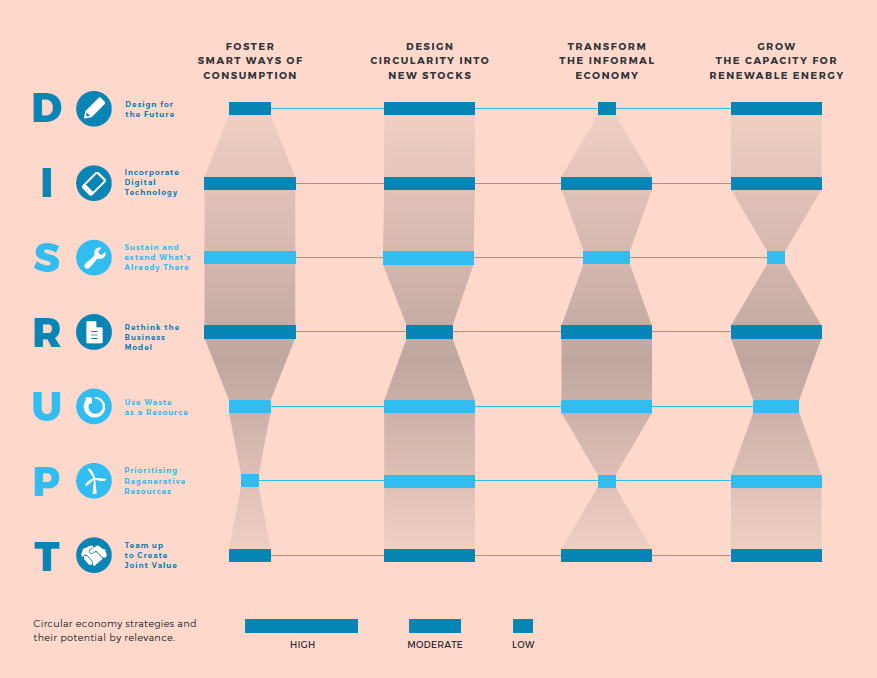January 21, Davos – The 3rd Global Circularity Gap Report finds that consumption of the global economy surpassed 100 billion tonnes of materials a year. That amount is unprecedented. Next to this, the world’s economy is now only 8.6% circular. This has fallen from 9.1% in the two years since the annual Global Circularity Gap report was first launched in 2018.
Media coverage: The Guardian (World material consumption hits 100bn a year), Bloomberg (waste free economy catches on), National Geographic (How a circular economy could save the world), Triodos Bank (Sounding the alarm), World Economic Forum (the world needs a circular economy), Business Green (Business as usual is dead), Common Dreams (Humanity risking global disaster), Ecologist (Global consumption hist 100bn tonnes), Duurzaam ondernemen, Volkskrant.
Circularity in decline: from 9.1 to 8.6% in two years
Today, the global economy is only 8.6% circular — just two years ago it was 9.1%. The global circularity gap is widening. There are reasons for this negative trend, but the result remains the same: the news is not just bad, it is worse. The negative trend overall can be explained by three related, underlying trends: high rates of extraction; ongoing stock build-up; plus, low levels of end-of-use processing and cycling.

The report finds that total resources entering the global economy have increased by 8.4% in just two years from 92.8 billion tonnes in 2015 to 100.6 billion tonnes in 2017, the latest year for which data is available.
In that period total extracted resources have increased by 9%, from 84.4 to 92 billion tonnes. But the total of materials that are reused has grown by just 3%, from 8.4 to 8.65 billion tonnes, and fallen as a proportion of overall material use.
These trends are embedded deep within the ‘take-make-waste’ tradition of the linear economy — the problems are hardwired. As such, the outlook to close the circularity gap looks bleak under the dead hand of business as usual. We desperately need transformative and correctional solutions; change is a must.
On a positive note, we do see that, in parts of the world, recovery rates are on the increase. This is steered by comprehensive government policy and technical innovation and investment directed at increasing material efficiency, extending and intensifying use and enabling end-of-life recovery. An initial cohort of countries have engaged with the circular agenda, ranging from individual nation states in Europe, to the giant economy of China. Recent years have also witnessed a steady stream of new players adopting circular economy policies and roadmaps.

Meeting societal needs within planetary boundaries
Closing the circularity gap serves the higher objective of preventing further and accelerated environmental degradation and social inequality. The end goal is to establish an ecologically safe and socially just operating space for mankind. As laid out in the Sustainable Development Goals and the Paris Agreement, countries have an important role to play.
Some countries operate well within the ecological boundaries of our planet, but without satisfying certain basic social needs. Conversely, other countries increasingly provide basic levels, but do so by overshooting the sustainable means of the planet. Effectively, therefore, all countries are developing now: each starts from a different point on the map; many share commonalities in their journey; but, all have a distance to go.
In principle, all countries are unique when it comes to their ecological footprint and ability to provide for their people. In practice, some face similar barriers and many are confronted with the same global trends. So, zooming in from the global footprint to look at satisfying national, regional and local societal needs, this Circularity Gap Report examines and extrapolates common challenges and opportunities experienced by distinct country groups. When circularity goes from bad to worse, we explore the power of countries to change the global game.
Eto Dvor, an initiative in Almaty Kazakhstan to use waste materials to build playgrounds playgrounds reuse recycling green growth SDG Kazakhstan
But nobody starts from scratch

The Circularity Gap Report provides on the ground examples across the globe to illustrate how the practical implementation of circular economy strategies and solutions is an everyday reality — right now. This global groundswell of positive action is happening bottom-up: from waste processing in Nigeria, to digital solutions empowering informal trash collectors in Brazil. Today, we see entrepreneurs, businesses and communities coming together with city officials leading the way.
Next to this, there is an increasing number of countries and national governments that are shaping their strategies to support investment towards sustainable and specific circular economy agendas. 13 European countries have adopted national circular roadmaps and in 2019 Colombia became the first Latin American country to launch a similar policy. China’s ban on waste imports aims to encourage domestic recycling, but it has also stimulated the development of circular economy strategies in Australia and other countries which previously exported their waste there.
National strategies to improve living standards within ecological boundaries
The report says national governments are key to shifting from a linear to a circular economy. It calls on them to collaborate on circular strategies to measure and improve resource efficiency, to translate global trends into national roadmaps, and to work with businesses, NGOs and academics to drive action.
It classifies countries into three broad categories – Build, Grow and Shift – depending on the living standards of their population and their ecological footprint, and it identifies circular strategies for each grouping.

1. Circular economy strategies in Build countries

Build countries have a low material footprint per capita. As a result, the impact of their economic activities often falls within the regenerative capacity of the planet. On the downside, however, they are struggling to meet all basic needs, not least in relation to HDI indicators such as education and healthcare. Natural capital, rather than human capital, is their dominant source of wealth, which means that the focus is on extraction and sale of raw materials, rather than investing in education and skills.
The good news is their potential: as Build countries are building-up their basic infrastructure for public services, hospitals and transport, they have an opportunity to apply circular strategies such as modular, passive and flexible design, also improving comfort by prioritising regenerative resources in buildings. Furthermore, the decentralised nature of the informal economy prevalent in Build countries provides a platform on which to develop distributed professional services that allow welfare to grow, while avoiding the operational inefficiencies which characterise infrastructure in Shift countries.
Key circular economy strategies in Build countries with existing examples:

- Design circularity into new stocks. Successful stock build-up must therefore be seen first and foremost as a design issue. Design for the future determines material usage during construction and throughout the whole lifetime of stock, plus flexibility for different use cycles, as well as lifetime energy consumption and material value at end-of-life.Circular and passive building design in Namibia and Zimbabwe. Local, renewable and recycled construction materials were prioritised during the construction of the Habitat Research and Development Center in Katutura, Namibia. The use of these materials makes the building fit within cultural preferences and retain a Namibian signature, while passive design principles provide adequate cooling. Another example is the Tebogo Home in Orange Farm, South Africa, where passive design principles keep indoor temperatures pleasant, while relying on local construction materials. Finally, already back in 1996 the Eastgate Centre in Harare, Zimbabwe applied passive heating and cooling principles, biomimicking airflow principles of thermite mounts.
- Empower the informal economy. Recycling rates are high in build countries because waste provides a valuable source of revenue to informal workers. There is scope to build on this by educating workers about circular solutions and providing them with the tools and frameworks to implement them.
- Use digital technology to support new business models. Some 240,000 smallholder farmers in Africa and Asia have used text messages to rent tractors through the Hello Tractor scheme. Education can help develop the entrepreneurs who will create new circular businesses and a workforce with the skills to fill them.
- Build a sustainable bioeconomy. Waste from agriculture, forestry and fisheries can be recycled and used to feed new industries. A programme in Niger has helped subsistence farmers reclaim degraded land and increase crop production by protecting and managing the growth of trees, benefiting 2.5 million people.
2. Circular economy strategies in Grow countries
Most Grow countries have already experienced a degree of economic growth and industrialisation, broadly expected to continue due to a combination of rising standards of living and population increase. As a result, resource use in these countries is characterised by fast economic growth and associated material consumption, rapid stock build-up and an expanding industrial sector (also responding to demand from Shift countries). In part, therefore, sustainable growth is about more efficient use of natural capital — investing earnings from the likes of minerals into infrastructure and education, thereby developing human capital. Such investment results in growth of total wealth.

Designing new infrastructure, buildings and consumer goods in a circular manner, simultaneously considering both enhanced durability for lifetime optimisation and end-of-life scenarios, are key strategies for these countries to become more circular. Alongside this, professionalising and improving the labour conditions in the informal parts of waste management in these countries also bears potential to reduce the environmental impact of both industrial and consumer waste.
Key circular economy strategies in Grow countries with existing examples:
- Foster smart consumption, using new technology and design to increase material efficiency and introducing sharing business models. It is possible to encourage product-service models, whilst also meeting minimum socio-economic and environmental standards. Dichung, for example, is a ride sharing platform and social enterprise in Vietnam; and Gojek offers a range of mobility, nutrition, payment and cleaning services via its application in Indonesia.

The potential of specific circular economy strategies in grow countries. - Design in circularity in stock and consumer goods. Long-term infrastructure being built now must be durable, adaptable and upgradable. China has pioneered eco-industrial parks where the waste of one business becomes the feedstock for another. Engineered solutions can offer some additional versatility around sustainable construction materials. Companies like HWZ International and XLAM, for example, are actively promoting Cross Laminated Timber as a lightweight but strong structural product in South Africa, where timber-frame buildings are already commonplace in higher market segments. As part of a drive to rethink the business model, offsite construction also allows for major efficiency improvements. Such modern methods of construction are already at 6% market share in China, where the process is referred to as industrialised building. Other countries such as Tanzania and India, where Modulex operates, confirm that it can reduce construction time by up to 50%.
- Transform informal recycling. In Brazil a mobile phone app is linking residents with informal waste collectors who sell recyclable materials to scrap centres. In Ghana, where up to 10,000 people work in Accra’s Agbogbloshie scrapyard dismantling everything from toasters to aircraft, a programme offers training to become designers and manufacturers so they can get greater value from their work.The estimated 400,000 informal waste collectors in Brazil are known as ‘Catadores’. They collect waste and recyclable materials and sell them to scrap centres. Cataki is an application which has been launched to inform Brazilians about the importance of catadores. The catadores can create a profile on the app and become contactable by residents to organise the collection of their recyclable materials. The initiative won a UNESCO digital innovation award in 2018.

Hydropower development in China. - Grow the capacity and grids for renewable energy. This will help decarbonise economies and avoid leaving countries with costly fossil fuel-based stranded assets. China is leading the global transition and has invested more than US$758 billion in renewable energy in the last decade. Costa Rica also features in the vanguard of country ambition with a target of becoming carbon neutral by 2050 — chiefly by electrifying transport and lowering private car usage, whilst its power production is already largely renewable and deforestation has been stopped.
3. Circular economy strategies in Shift countries
Shift countries, such as member states of the EU, US and Japan, maintain the highest proportion of services as part of their GDP. Yet, their material consumption is 10 times greater than that of the Build countries. They also produce high volumes of waste, although what they process in-country themselves is usually managed relatively efficiently. With consumption levels exceeding several planetary boundaries, however, the true impact of Shift countries extends far beyond their national borders, with much of the environmental and social costs incurred elsewhere.

Ultimately, Shift countries need to stop passing the buck and take responsibility for these impacts, regardless
of where they occur. To that end, they can start incentivising the dematerialisation of consumption by aligning their tax regimes with sustainabilityambitions. One other characteristic of Shift countries is their distinctive demographic: the population tends to be relatively small and ageing; although, when it comes to sustainability matters, most notably and recently climate, it is the younger
generation that have adopted a clear position, taken to the streets and made a stand on the global stage. Their activism is an increasingly influential factor in social change.
Key circular economy strategies in Shift countries with existing examples:
- Shift to smarter consumption by leading the way on circular design, extending product lifetimes and using fewer materials.The Dutch CIRCO programme targets specific industries or material flows with circular design classes. Subsidised by the government to reduce prices by around 75%, these workshops often have aregional focus to allow for synergies across industries, whilst targeting specifics such as bike manufacturing, horticulture, or organic fibres. In the Netherlands, Fairphone has developed a modular phone using replaceable, ethically sourced parts. Ownership of goods is being replaced by sharing and service business models on everything from jeans to dishwashers – membership of car sharing schemes is growing globally at 65% a year.

The potential of specific circular economy strategies in shift countries. - Take responsibility for the impact of imports and exports. Shared standards for health, safety and the environment should be applied across borders throughout the value chain, including waste processing. In Sweden, for example, reduced tax on repair, maintenance and rebuilding of private dwellings aims to boost employment, whilst shrinking the volume of undeclared work, at the same time. In general, lowering labour tax and increasing environmental taxation is an attractive budget-neutral way to encourage circular design and repair, plus discourage disposal and consumption of single-use products — be they plastics or fossil fuels. Studies show that such alignment of the tax regime with sustainable development ambitions pays off, according to economic models developed by the NGO Ex’tax. Innovative schemes use waste as a resource, for example, Interface is collecting used fishing nets in the Philippines and using the waste nylon in its carpet tiles.
- Drive the renewable energy transition by decarbonising their economies and creating abundant renewable capacity, storage and smart grid systems. A transition to 100% renewable energy in the US would see a net increase of 2 million jobs, halve energy costs for consumers and save taxpayers US$600 billion in healthcare costs and US$3.3 trillion in climate costs, according to Stanford University research.
Shifting Paradigms supported Circle Economy with collecting case study examples and drafting the build, grow, shift chapters.
Client: Circle Economy
2019-20
See also the recording of a webinar by Circle Economy while the report drafting was still ongoing.



